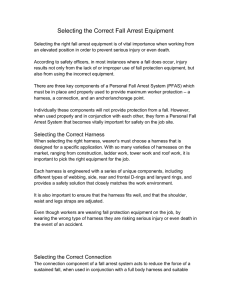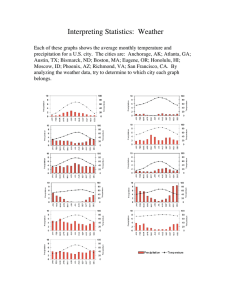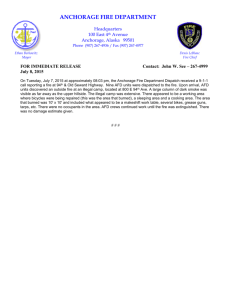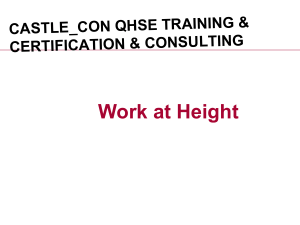Toolbox Talk: Fall Protection
advertisement
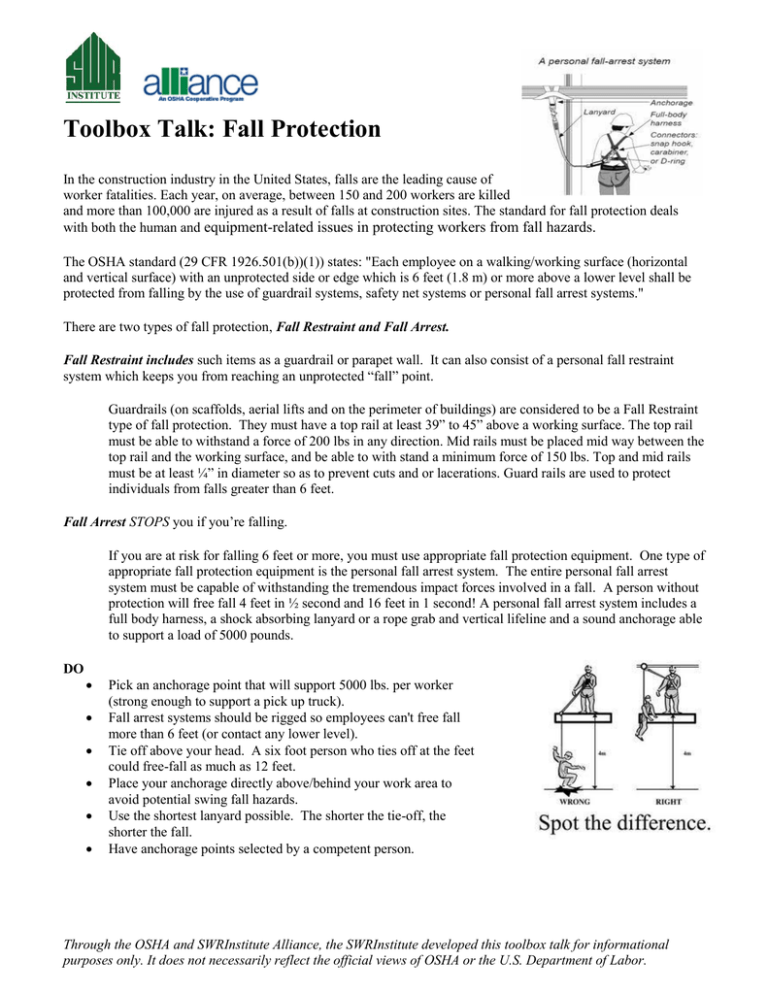
Toolbox Talk: Fall Protection In the construction industry in the United States, falls are the leading cause of worker fatalities. Each year, on average, between 150 and 200 workers are killed and more than 100,000 are injured as a result of falls at construction sites. The standard for fall protection deals with both the human and equipment-related issues in protecting workers from fall hazards. The OSHA standard (29 CFR 1926.501(b))(1)) states: "Each employee on a walking/working surface (horizontal and vertical surface) with an unprotected side or edge which is 6 feet (1.8 m) or more above a lower level shall be protected from falling by the use of guardrail systems, safety net systems or personal fall arrest systems." There are two types of fall protection, Fall Restraint and Fall Arrest. Fall Restraint includes such items as a guardrail or parapet wall. It can also consist of a personal fall restraint system which keeps you from reaching an unprotected “fall” point. Guardrails (on scaffolds, aerial lifts and on the perimeter of buildings) are considered to be a Fall Restraint type of fall protection. They must have a top rail at least 39” to 45” above a working surface. The top rail must be able to withstand a force of 200 lbs in any direction. Mid rails must be placed mid way between the top rail and the working surface, and be able to with stand a minimum force of 150 lbs. Top and mid rails must be at least ¼” in diameter so as to prevent cuts and or lacerations. Guard rails are used to protect individuals from falls greater than 6 feet. Fall Arrest STOPS you if you’re falling. If you are at risk for falling 6 feet or more, you must use appropriate fall protection equipment. One type of appropriate fall protection equipment is the personal fall arrest system. The entire personal fall arrest system must be capable of withstanding the tremendous impact forces involved in a fall. A person without protection will free fall 4 feet in ½ second and 16 feet in 1 second! A personal fall arrest system includes a full body harness, a shock absorbing lanyard or a rope grab and vertical lifeline and a sound anchorage able to support a load of 5000 pounds. DO Pick an anchorage point that will support 5000 lbs. per worker (strong enough to support a pick up truck). Fall arrest systems should be rigged so employees can't free fall more than 6 feet (or contact any lower level). Tie off above your head. A six foot person who ties off at the feet could free-fall as much as 12 feet. Place your anchorage directly above/behind your work area to avoid potential swing fall hazards. Use the shortest lanyard possible. The shorter the tie-off, the shorter the fall. Have anchorage points selected by a competent person. Through the OSHA and SWRInstitute Alliance, the SWRInstitute developed this toolbox talk for informational purposes only. It does not necessarily reflect the official views of OSHA or the U.S. Department of Labor. DON’T Do not tie off to vent pipes or a non-structured non-designated area. Do not tie a knot in lanyard. This will reduce its strength. Do not use water pipes, electrical conduits, light fixtures, or guardrails as anchor points. Do not use any lanyards without self locking snap hooks. Do not join multiple lanyards together to reach an anchorage. Do not allow more than one worker to tie-off to the same anchorage unless it is designed and approved by an engineer. Do not unhook from fall protection while exposed to a fall greater than 6 feet. Do not allow someone else to rig your equipment unless you verify that it has been done correctly. Do not use an anchorage that is not independent of any anchorage used to support or suspend platforms. Checklist: Inspect your equipment daily. Look for fraying ropes, crack of other defects in hardware. Tag and remove defective equipment from service Make sure you are attached to a sound anchorage. If there is any doubt about the safety of the equipment, do not use it. Replace any equipment, including ropes, involved in a fall. Five Parts of a Personal Fall Arrest System 1. 2. 3. 4. 5. Anchorage – 5000 lb. minimum Lifeline Rope Grab Lanyard Full Body Harness Guardrail Systems 1. Top rail must be 39” to 45” 2. Withstand 200lbs of force 3. Mid Rail withstand 150lbs of force 4. Top, Mid Rails must be a min. ¼”dia. 5. Toe boards must be 3.5” high and able to withstand 50lbs of force. Review Questions: 1) Anchor points must support 5000 pounds for Fall Arrest. a) True b) False 2) Fall Arrest and Fall Restraint are the same kind of fall protection. a) True b) False 3) How close can you come to an unprotected side or edge of a fall greater than 6 feet? a) There is no safe distance unless you are wearing adequate fall protection PPE or there is a parapet wall or guard rail at least 42” in height. b) 4 feet if it is not windy c) 2 feet if there is someone close to you holding your belt d) 5 feet as long as there is no lightning Through the OSHA and SWRInstitute Alliance, the SWRInstitute developed this toolbox talk for informational purposes only. It does not necessarily reflect the official views of OSHA or the U.S. Department of Labor. Talk Given By: ___________________________ Date: ______________________ Company: _______________________________ Location: ___________________ Printed Name Signature Through the OSHA and SWRInstitute Alliance, the SWRInstitute developed this toolbox talk for informational purposes only. It does not necessarily reflect the official views of OSHA or the U.S. Department of Labor.
